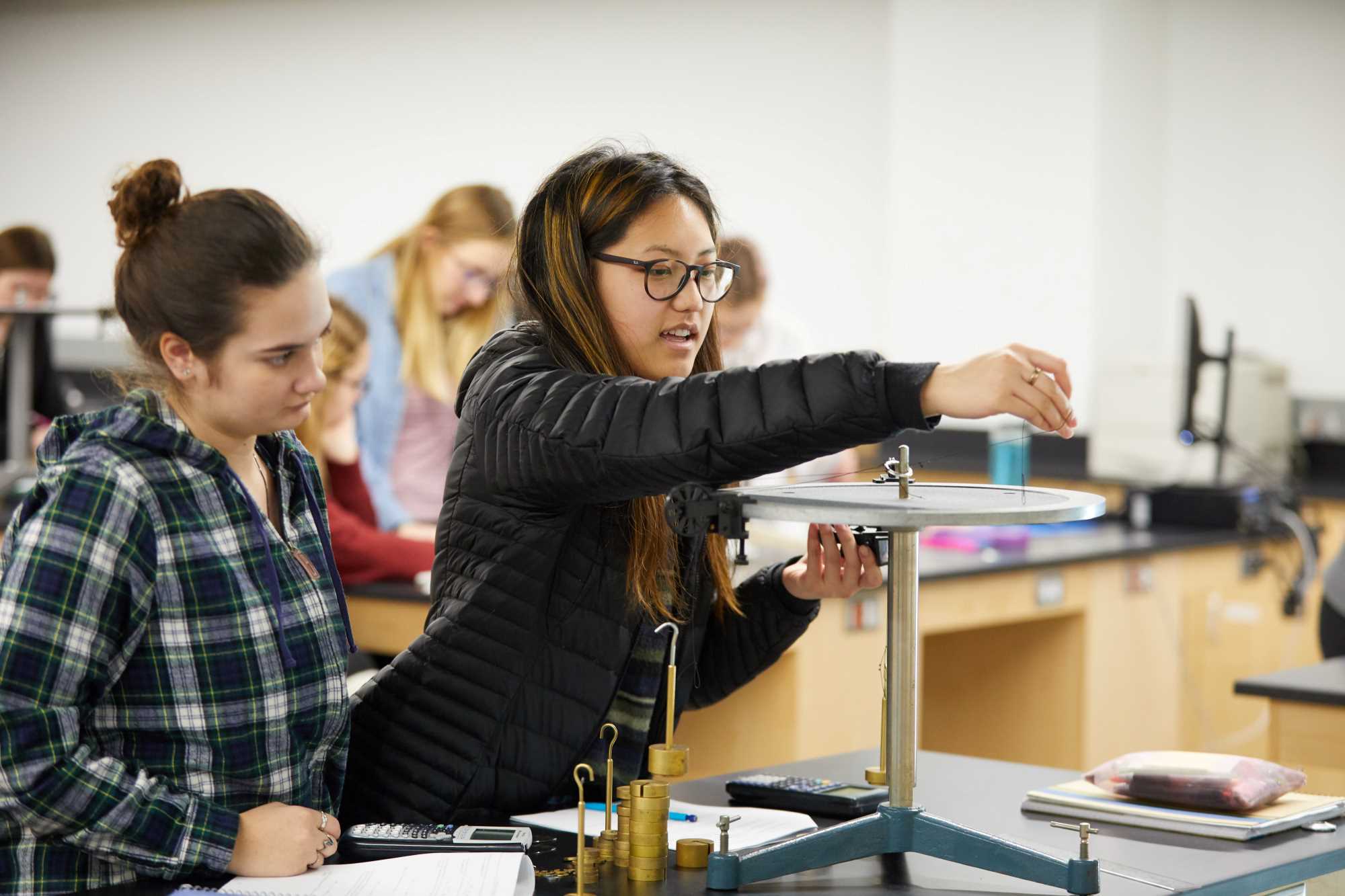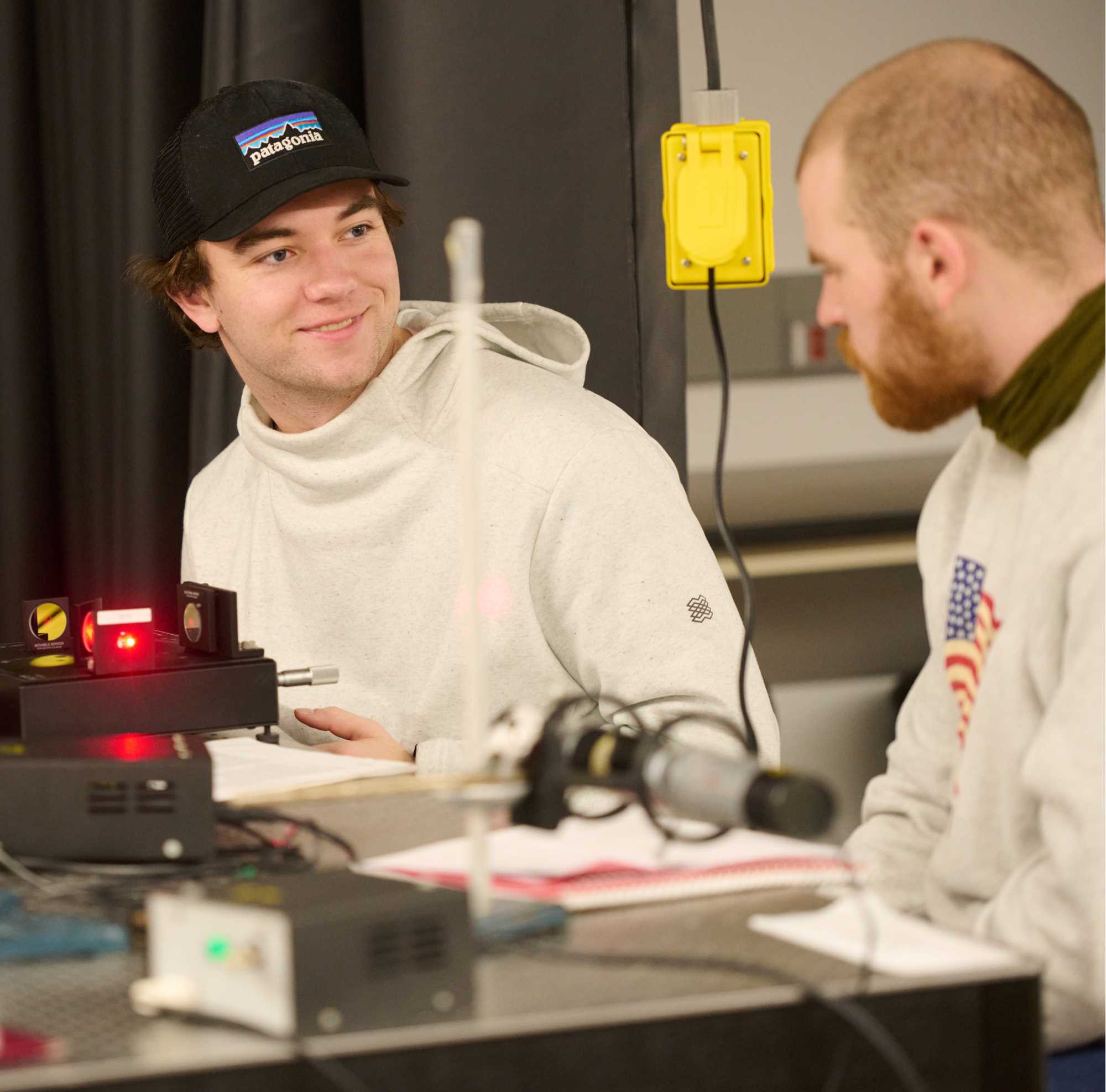Physics program
Are you curious about how things work?
From renewable energy solutions like wind power to the microchips that power your devices, physics is behind the technology we use every day. Even the GPS on your phone relies on Einstein's famous Theory of General Relativity.
A degree in physics provides robust quantitative, analytical, and experimental skills to prepare you for careers in high-tech industries, medicine, engineering, and a range of graduate programs. If you are curious and enjoy problem solving, physics may be the perfect fit for you.
UWL's Physics Department is a nationally-recognized leader in physics education and one of the largest undergraduate physics programs in Wisconsin. Students experience a quality physics education in a supportive community with many opportunities to work closely with faculty on undergraduate research projects.
Physics
Physicists study and uncover the fundamental rules of why and how things work, from quarks to galaxies. Physicists have uncovered some really weird and unexpected things about nature. But applying these principles of physics has transformed the way we interact with the world. Physics concepts are in action all around us — in computer chips, headphones, air bags, and many other everyday devices. It has also made a major impact in healthcare with medical diagnostics and treatments like MRIs and radiation therapy.
Undergrad major Undergrad minor View a sample plan for Physics Catalogfor Physics Learn more for PhysicsApplied Emphasis
The applied emphasis gives you theoretical background to focus on the experimental aspect of physics. While not an engineering degree, this emphasis requires the same basic classes as the Bachelor of Science in Physics & Bachelor of Science in Engineering Dual Degree Program.
Undergrad major View a sample plan for Applied Catalogfor AppliedAstronomy Emphasis
The science of astronomy applies principles of physics to everything beyond Earth’s atmosphere. Students use what they learn in core classical and modern physics courses to study the properties of stars, planets and exoplanets, white dwarfs, neutron stars, black holes, other galaxies, dark matter, dark energy, and cosmology.
Undergrad major Undergrad minor View a sample plan for Astronomy Catalogfor AstronomyBiomedical Concentration
Do you like physics, mathematics, chemistry, and biology? Are you struggling to choose just one for a major? You don’t have to with the biomedical concentration! This physics concentration combines all of these subjects by providing a set of core courses and allowing you to choose the advanced courses you will take to prepare for your future. Whether you are looking ahead to the rigors of medical school, a program in medical physics, a future in biomedical engineering or other options, a biomedical concentration could be the perfect path for you.
Undergrad major View a sample plan for Biomedical Catalogfor BiomedicalBusiness Concentration
Combine physics with business to grow your problem-solving skills while expanding your background in business including economics, accounting, finance and marketing. This concentration requires the physics core courses and provides the flexibility to choose from 12 additional physics classes from a catalog of classes. The rest of the classes are taught in the College of Business Administration.
Undergrad major View a sample plan for Business Catalogfor BusinessComputational Physics Emphasis
Computational physics employs mathematics, computer science and physics to solve complex problems using computational methods.
Undergrad major View a sample plan for Computational Physics Catalogfor Computational PhysicsScience Education
Completion of the physics: science education concentration program and associated benchmark assessments will lead to endorsement for the Wisconsin teaching license in middle and high school science, grades 4-12 (2600). Students in all teacher education programs must satisfy the School of Education (SOE) core requirements.
Undergrad major Teacher license View a sample plan for Science Education Catalogfor Science EducationOptics Emphasis
From lasers and light-emitting diodes (LEDs) to fiberoptics, microscopes, spectrometers and telescopes, optical instruments play a key role in how we live and study the universe around us. In this emphasis, students take specialized optics courses where they learn about the fundamental properties of light and how modern optical instruments work.
Undergrad major View a sample plan for Optics Catalogfor OpticsUndergrad dual degree
This is special dual degree program enables students to receive both a Bachelor of Science degree (physics major) from UWL and a Bachelor of Science degree (engineering major) from UW-Madison, UW-Milwaukee, UW-Platteville, UW-Stout, the University of Minnesota Duluth, or Winona State University. The total length of time for both degrees is expected to be five years.
Undergrad major Graduate degree View a sample plan for Undergrad dual degree Catalogfor Undergrad dual degreeGraduate dual degree
This dual degree program enables students to receive both a Bachelor of Science degree (physics major with biomedical concentration) and a graduate degree (physical therapy) from UWL. The total length of time for both degrees is expected to be six years.
Undergrad major Graduate degree Doctoral degree View a sample plan for Graduate dual degree Catalogfor Graduate dual degreePhysics degree jobs
UWL’s diverse physics program makes graduates highly sought after in modern industries where physics and engineering are applied. In addition, many UWL physics graduates are accepted into top graduate degree programs where they can pursue a master’s or doctoral degree. Learn more about the career paths of 50 different physicists on The American Physical Society website.
Career examples
- Engineering physicists
- Research physicists (government or private industry)
- Space scientist
- Science policy
- Radiation safety officer
- High school science teacher (with teacher certification)
- Planetarium director
- Technical writer
Further education
- Physics
- Engineering
- Chemistry
- Astrophysics
- Optical science
- Medical physics
- Mathematics
- Computer science
What distinguishes UWL's Physics program?
UWL has one of the largest undergraduate physics programs in Wisconsin. And the program also has a national reputation for awarding physics degrees. In 2020, UW-La Crosse was ranked No. 1 nationally in awarding physics bachelor’s degrees, according to the American Physical Society. The department is consistently ranked among the top.
- Earned the American Physical Association Award for Improving Undergraduate Physics Education.
- Highlighted by the American Association of Physics Teachers (AAPT) as one of the most outstanding revitalized physics programs in the nation.
- Selected for a site visit from the American Institute of Physics to learn and promote the Physics Department’s effective practices for the preparation of physics undergraduates for STEM careers as part of the AIP Career Pathways Project in 2012.
The Physics Department places an emphasis on student involvement in undergraduate research. This research contributes to the sense of community throughout the department. Research projects are available in astrophysics, biomechanics, biophysics, computational physics, quantum optics, material science, nuclear physics, solid-state physics and physics education.
The Physics Department annually hosts a physicist who has won the Nobel Prize as part of a Distinguished Lecture Series in Physics. The laureates meet and interact with students, faculty and staff, along with giving a public lecture and physics seminar related to their unique discovery. The department has hosted Nobel laureate nearly every year since 2000, thanks to the generosity of members of the La Crosse Community.
The department’s chapter of the Society of Physics Students (SPS) routinely receives Outstanding Chapter Award from the national SPS office. Additionally, the department sponsors a chapter of Sigma Pi Sigma (the physics honor society), a Physics Club, and a Women and Minorities in Physics Club.
Faculty are actively engaged in research in a variety of fields and involve undergraduate students in their research endeavors. The Physics Department faculty have received more than $2 million dollars in external funding from the National Science Foundation, NASA, and other external agencies to support faculty and student research activities in the last six years.
The Physics Department has all of its experimental facilities in UWL's modern science labs building, the Prairie Springs Science Center. The use of high-tech research equipment and laboratories prepare students for the skills required in the modern world as all faculty labs are available for student research. Students also have access to a multidisciplinary radiation center.
Scholarship opportunities are available for students majoring in physics or physics/engineering. Physics students have also received a number of awards, fellowships, and scholarships based on their academic performance and ability to excel in research, including nationally competitive awards.
















